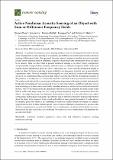| dc.contributor.author | Zhang, Wenjun | |
| dc.contributor.author | Liu, Yuming | |
| dc.contributor.author | Ratilal, Purnima | |
| dc.contributor.author | Cho, Byunggu | |
| dc.contributor.author | Makris, Nicholas | |
| dc.date.accessioned | 2018-05-16T20:05:41Z | |
| dc.date.available | 2018-05-16T20:05:41Z | |
| dc.date.issued | 2017-09 | |
| dc.date.submitted | 2017-07 | |
| dc.identifier.issn | 2072-4292 | |
| dc.identifier.uri | http://hdl.handle.net/1721.1/115418 | |
| dc.description.abstract | A number of nonlinear acoustic sensing methods exist or are being developed for diverse areas ranging from oceanic sensing of ecosystems, gas bubbles, and submerged objects to medical sensing of the human body. Our approach is to use primary frequency incident waves to generate second order nonlinear sum or difference frequency fields that carry information about an object to be sensed. Here we show that in general nonlinear sensing of an object, many complicated and potentially unexpected mechanisms can lead to sum or difference frequency fields. Some may contain desired information about the object, others may not, even when the intention is simply to probe an object by linear scattering of sum and difference frequency incident waves generated by a parametric array. Practical examples illustrating this in ocean, medical, air and solid earth sensing are given. To demonstrate this, a general and complete second-order theory of nonlinear acoustics in the presence of an object is derived and shown to be consistent with experimental measurements. The total second-order field occurs at sum or difference frequencies of the primary fields and naturally breaks into (A) nonlinear waves generated by wave-wave interactions, and (B) second order waves from scattering of incident wave-wave fields, boundary advection, and wave-force-induced centroidal motion. Wave-wave interactions are analytically shown to always dominate the total second-order field at sufficiently large range and carry only primary frequency response information about the object. As range decreases, the dominant mechanism is shown to vary with object size, object composition, and frequencies making it possible for sum or difference frequency response information about the object to be measured from second-order fields in many practical scenarios. It is also shown by analytic proof that there is no scattering of sound by sound outside the region of compact support intersection of finite-duration plane waves at sum or difference frequencies, to second-order. Analytic expres sions for second-order fields due to combinations of planar and far-field wave-wave interactions are also derived as are conditions for when wave-wave interactions will dominate the second order field. Keywords: nonlinear acoustics; parametric array; sum and difference frequency sensing; nonlinear scattering | en_US |
| dc.publisher | MDPI AG | en_US |
| dc.relation.isversionof | http://dx.doi.org/10.3390/RS9090954 | en_US |
| dc.rights | Attribution 4.0 International (CC BY 4.0) | en_US |
| dc.rights.uri | https://creativecommons.org/licenses/by/4.0/ | en_US |
| dc.source | MDPI | en_US |
| dc.title | Active Nonlinear Acoustic Sensing of an Object with Sum or Difference Frequency Fields | en_US |
| dc.type | Article | en_US |
| dc.identifier.citation | Zhang, Wenjun et al. “Active Nonlinear Acoustic Sensing of an Object with Sum or Difference Frequency Fields.” Remote Sensing 9, 9 (September 2017): 954 © 2017 The Authors | en_US |
| dc.contributor.department | Massachusetts Institute of Technology. Department of Electrical Engineering and Computer Science | en_US |
| dc.contributor.department | Massachusetts Institute of Technology. Department of Mechanical Engineering | en_US |
| dc.contributor.mitauthor | Zhang, Wenjun | |
| dc.contributor.mitauthor | Liu, Yuming | |
| dc.contributor.mitauthor | Ratilal, Purnima | |
| dc.contributor.mitauthor | Cho, Byunggu | |
| dc.contributor.mitauthor | Makris, Nicholas | |
| dc.relation.journal | Remote Sensing | en_US |
| dc.eprint.version | Final published version | en_US |
| dc.type.uri | http://purl.org/eprint/type/JournalArticle | en_US |
| eprint.status | http://purl.org/eprint/status/PeerReviewed | en_US |
| dc.date.updated | 2018-05-04T18:22:54Z | |
| dspace.orderedauthors | Zhang, Wenjun; Liu, Yuming; Ratilal, Purnima; Cho, Byunggu; Makris, Nicholas | en_US |
| dspace.embargo.terms | N | en_US |
| dc.identifier.orcid | https://orcid.org/0000-0001-5895-1157 | |
| dc.identifier.orcid | https://orcid.org/0000-0003-2238-364X | |
| dc.identifier.orcid | https://orcid.org/0000-0003-4369-296X | |
| mit.license | PUBLISHER_CC | en_US |
